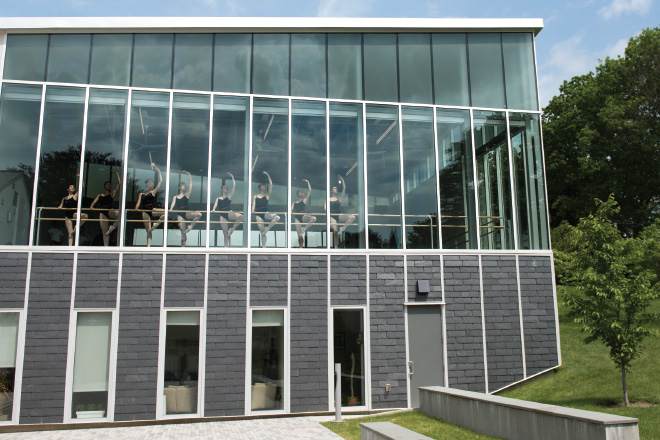Article by Jane Segale, Walnut Hill School for the Arts
Feature image courtesy of Walnut Hill School for the Arts.
During my first year at Walnut Hill School for the Arts, I took part in an exercise Head of School Antonio Viva fondly called “Kill the School!” As frightening as the name may sound, the idea was the opposite: The exercise asked school administrators to put ourselves in the shoes of a competitor and explore ways that students might be drawn away from Walnut Hill. At the end of the exercise, we would brainstorm ways to strengthen the value proposition of our program.
If our mission is to educate and train creative and intellectually curious young artists, why weren’t we leveraging these organizations to provide our students with real-life experiences and expose them to top-tier talent?
It was clear to me from the start that Walnut Hill was heavily tuition-dependent, and the biggest threat to the school’s long-term sustainability was enrollment. So, I was excited to be part of a team that was tasked with thinking creatively and committed to making bold, mission-aligned changes at the school.
The exercise quickly revealed that we were not taking advantage of one of our greatest assets, our proximity to Boston and the large number of artistic institutions housed there — not just museums, ballet and theater companies, but also educational institutes like Mass Art, New England Conservatory and Berklee College of Music. If our mission is to educate and train creative and intellectually curious young artists, why weren’t we leveraging these organizations to provide our students with real-life experiences and expose them to top-tier talent?
Joint Solutions
We soon began conversations with Boston Ballet to form a partnership with our dance program, which had experienced enrollment challenges due to high competition. Boston Ballet had a successful pre-professional program, but had long struggled with supporting the 14- to 18-year-old students in this program, who came from all over the country. The students often travelled to Boston alone and had to coordinate their own housing, meals and education, either through online high school programs or local public or private schools, where schedules would often conflict with their dance training.
In September 2020, the school launched Boston Ballet School’s Professional Division at Walnut Hill. Its mission is to provide world-renowned dance instruction with a best-in-class college preparatory program and deliver a holistic educational experience.
In the new partnership, Boston Ballet does most of the recruiting of young dancers, who now also go through Walnut Hill’s admission process. The admitted dancers are integrated into the school community — both academic and student life — while training in the revamped dance program which is artistically directed by Boston Ballet. The dance faculty are from Walnut Hill and Boston Ballet, and the program offers both on-campus training and off-campus experiences at Boston Ballet. While the pandemic has limited in-person and off-campus interactions, as Boston Ballet cancelled its season last year, we were able to take advantage of some virtual connections, and we plan to return to a full slate of engagements when the pandemic passes.
Lessons Learned
Boston Ballet has benefited from being able to attract young dancers from all over the world thanks to Walnut Hill’s ability to obtain student study visas as well as provide safe housing, stellar academics and a full high school experience for young dancers.
The partnership has increased excitement about and awareness of Walnut Hill, driving enrollment in the dance program and also raising the school’s profile in the art world more generally. Boston Ballet has benefited from being able to attract young dancers from all over the world thanks to Walnut Hill’s ability to obtain student study visas as well as provide safe housing, stellar academics and a full high school experience for young dancers.
The change was not without difficulties. Walnut Hill had to adjust staffing and provide transitional support to existing students as they adjusted to the new program’s expectations. Both institutions had to find a way to combine cultures. In addition, the business office has had to spend significant time developing clear guidelines on the size and scope of the program, determining what costs each organization is responsible for, and ensuring that Walnut Hill meets its budget goals and that the program is financially viable.
As we consider future partnerships, we know that we at Walnut Hill need to carefully evaluate how the partnerships evolve and who is ultimately responsible for the students and the program as well provide clear communication and support to all constituents affected. We continue to engage in team-building exercises and professional development to improve workplace culture and bring staff members together.
We are exploring how we can strengthen the school’s existing partnership with the New England Conservatory and this summer hosted their Summer Orchestra Institute for the first time. As we build on these two partnerships, we hope to be able to attract students from diverse backgrounds who might not typically be drawn to independent schools.
As CFO, I am excited to be part of this impactful change that has not only made our school more sustainable but also enhanced our mission to educate and train creative and intellectually curious young artists to make an enduring impact in the world.
Jane Segale is chief financial officer at Walnut Hill School for the Arts, a grades 9–12 day school for almost 300 students in Natick, Massachusetts.
h



